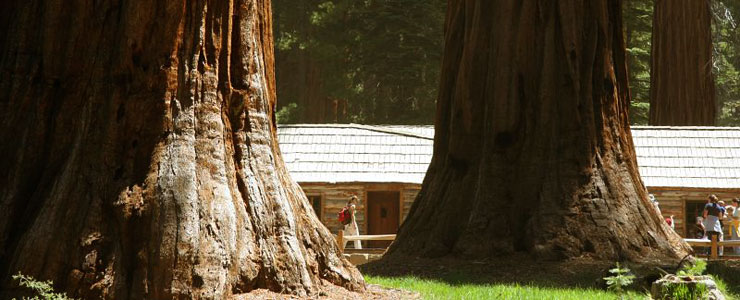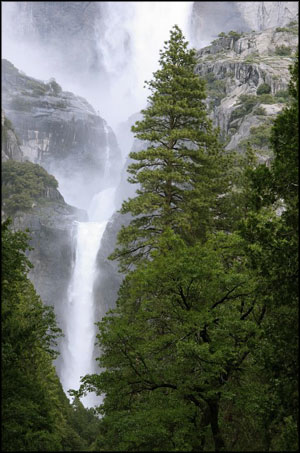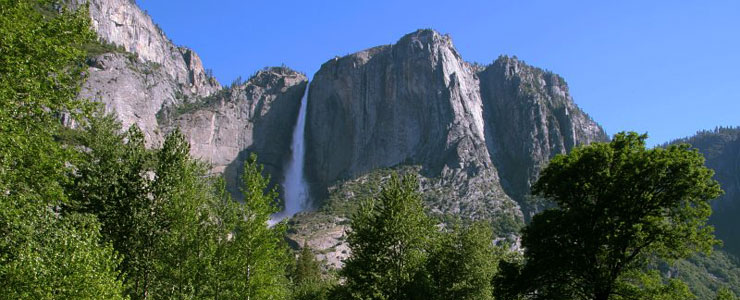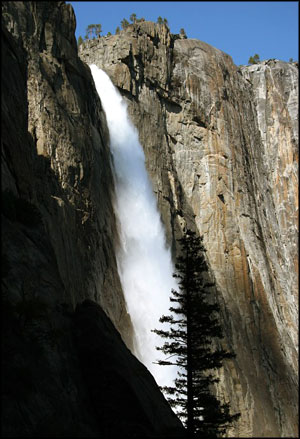Yosemite National Park

Giant sequoias in Yosemite Valley

Yosemite Falls
"It is by far the grandest of all the special temples of Nature I was ever permitted to enter." -- John Muir
Yosemite National Park contains almost 1200 square miles of mountainous terrain in the Sierra Nevada Mountains of central California. Large sections of the park are inaccessible from November (sometimes as early as September) into May (and sometimes June, depending on the amount of snowfall through the winter).
The park is a very popular place to visit (on average: 3.7 million people visit per year, and most of them never leave the seven-square-mile section in Yosemite Valley) and while you don't need reservations to enter the park, if you want to stay overnight in a campsite or room, you'll want to make reservations well in advance.
For several months in the summer, Yosemite Valley itself is a big, over-filled parking lot and many folks get around using the free shuttle system. Many also ride bikes, which are allowed in most of Yosemite Valley but are not allowed in the high country. Most roads in the park have vehicle restrictions, specifically regarding height, width and overall length of the unit. And most commercial vehicles are not allowed on park roads.


Vernal Falls
Yosemite National Park contains some 747,956 acres, of which about 89% is designated wilderness (677,600 acres). The area is home to more than 400 wildlife species and thousands of plant species. The park is a land of wild and rugged high country that drops off sheer granite cliffs to deep canyons followed by wild and scenic rivers (the Tuolumne and Merced Wild and Scenic Rivers both source in the uplands of Yosemite). The park offers 282 miles of roadway and more than 800 miles of hiking trails. Yosemite Falls is a spectacular 2,425-foot drop (highest in North America) but is only one of the many waterfalls that drop over the glacier-cut granite walls into Yosemite Valley. As much as Half Dome (at 8,842 feet in elevation) is a world-recognized sight/site, the high point in the park is Mount Lyell at 13,114 feet. Yosemite also harbors two glaciers (Lyell and Maclure) in the high country.
About 10 million years ago, vertical action along the Sierra Fault started the Sierra Nevada uplift. West of the ridgeline the ground uptilted slowly and that's why we see the relatively gentle slopes of the western Sierras. East of the ridgeline, the ground broke sharply and we're now left with the sharp, steep eastern slopes. As the force of the uplift increased, the slope increased, too, and the downward erosive action of the rivers increased, cutting the beginnings of today's valleys into the underlying granite. Then came the Ice Ages... between 2 and 3 million years ago, the glaciation started and there have been four major periods of ice in the Sierras since: the Sherwin, Tahoe, Tenaya and Tioga. The Sherwin glaciers were the largest and were responsible for the major sculpting of the Yosemite valleys. The later stages of glaciation were smaller and shorter. The Sherwin glaciers were 4,000 feet thick in areas, the longest one flowing down the Grand Canyon of the Tuolumne River for 60 miles. Some glaciers flowed east and emptied into what is now Mono Lake while others flowed down the canyon of the Merced River. At times, only the highest peaks in the area remained above the ice and when the glaciers eventually retreated, they left some massive moraines behind. One of those moraines dammed Yosemite Valley and impounded a lake some 5.5 miles long.


Upper Yosemite Falls
Yosemite first came under protection in 1864 as the Yosemite Grant. President Abraham Lincoln signed that legislation giving Yosemite Valley and the Mariposa Grove to the State of California who were in a better position to monitor and protect the area.
Native Americans had lived in the area for thousands of years but it was after only the first few years of the newcomer invasion that most Native Americans around Yosemite were either dead or displaced. The high country of the Sierras shows much evidence of the damage and destruction left behind after the miners came and went. Loggers did a lot of damage and destruction, too, but that tends to disappear over the years as the vegetation recovers and regrows. The federal government included the grant and a larger chunk of California into Yosemite National Park in 1890. The US Army was given jurisdiction over the property from 1891 to 1913.
Yosemite is open 24/7/365, however the Hetch Hetchy entrance station is only open during daylight and some entrances may be closed during winter.

Campgrounds at Yosemite National Park
Maps courtesy of the National Park Service